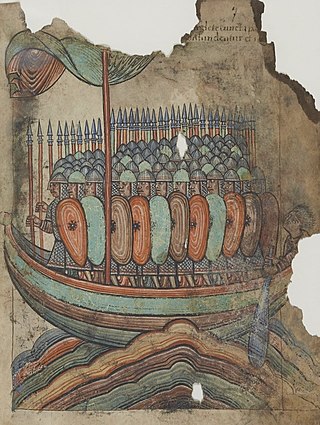The 830s decade ran from January 1, 830, to December 31, 839.
The 840s decade ran from January 1, 840, to December 31, 849.
The 850s decade ran from January 1, 850, to December 31, 859.
The 860s decade ran from January 1, 860, to December 31, 869.
The 870s decade ran from January 1, 870, to December 31, 879.

Year 844 (DCCCXLIV) was a leap year starting on Tuesday of the Julian calendar.

Year 847 (DCCCXLVII) was a common year starting on Saturday of the Julian calendar.

Year 845 (DCCCXLV) was a common year starting on Thursday of the Julian calendar.

Year 861 (DCCCLXI) was a common year starting on Wednesday of the Julian calendar.

Year 870 (DCCCLXX) was a common year starting on Sunday of the Julian calendar, the 870th year of the Common Era (CE) and Anno Domini (AD) designations, the 870th year of the 1st millennium, the 70th year of the 9th century, and the 1st year of the 870s decade.

Nominoe or Nomenoe was the first Duke of Brittany from 846 to his death. He is the Breton pater patriae and to Breton nationalists he is known as Tad ar Vro.
Erispoe was Duke of Brittany from 851 to his death. After the death of his father Nominoe, he led a successful military campaign against the Franks, culminating in his victory at the Battle of Jengland. He is subsequently referred to as "King of Brittany".
Salomon was count of Rennes and Nantes from 852 and duke of Brittany from 857 until his assassination in 874. In 867, he was granted the counties of Avranches and Coutances, and he used the title king of Brittany intermittently after 868.
Lambert II was the Frankish Count of Nantes and Prefect of the Breton March between 843 and 851. Lambert ruled the county in opposition to Amaury, the puppet count installed by Charles the Bald, King of West Francia. At his death, the county was effectively in Breton control. Lambert was the son of Lambert I and his wife Itta.
The Battle of Jengland took place on 22 August 851, between the Frankish army of Charles the Bald and the Breton army of Erispoe, Duke of Brittany. The Bretons were victorious, leading to the signing of the Treaty of Angers in September 851 and the recognition of Erispoe as the legitimate ruler of the Bretons under Charles the Bald.
The Battle of Ballon took place on 22 November 845 between the forces of Charles the Bald, king of West Francia, and Nominoë, Duke of Brittany. Nominoë was appropriating border territory and opposing Charles' attempt to impose Frankish authority. Nominoë defeated Charles, initiating a period of Breton expansion and consolidation of power.
Renaud (795–843) was Frankish Count of Herbauges, Count of Poitiers and Count of Nantes. His name is also spelled Rainaldus or Ragenold, and he is sometimes known as Reginald in English. He is referred to as Renaud of Aquitaine, but seems to have been a member of the Rorgonid family of Maine.
The Battle of Blain, also called the Battle of Messac, was fought on 24 May 843 by the forces of Lambert II of Nantes and Erispoe, prince of Brittany, against Renaud, Frankish Count of Nantes. It arose from Breton resistance to Frankish power within Brittany and disputes over control of the County of Nantes. The defeat of the Franks led to a period of Breton expansionism.

The Kingdom of Brittany was a short-lived vassal-state of the Frankish Empire that emerged during the Norse invasions. Its history begins in 851 with Erispoe's claim to kingship. In 856, Erispoe was murdered and succeeded by his cousin Salomon.

Vikings were active in Brittany during the Middle Ages, even occupying a portion of it for a time. Throughout the 9th century, the Bretons faced threats from various flanks: they resisted full incorporation into the Frankish Carolingian Empire yet they also had to repel an emerging threat of the new duchy of Normandy on their eastern border by these Scandinavian colonists.








